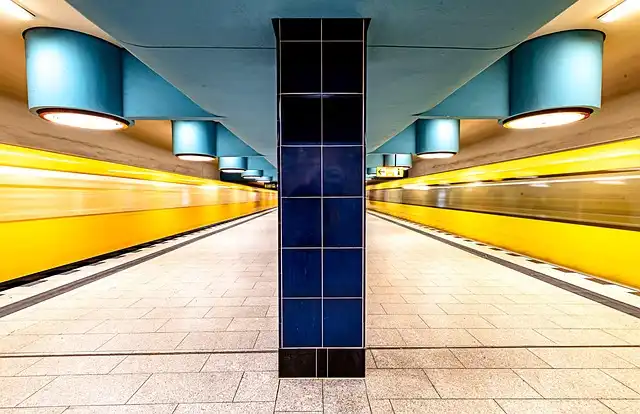Alfred Beach’s Secret Subway: Pneumatic Dreams & Political Realities

Alfred Beach's secret pneumatic subway under Broadway faced political hurdles despite its innovative design. A glimpse into early mass transit challenges and parallels with modern projects like Hyperloop.
Algeo contrasts Beach’s pneumatically-driven system to Elon Musk’s Hyperloop. Both profession on the love of secured tubes, structured vehicles, and sparkling stations encouraging rate and cleanliness.
Beach never obtained past the proof-of-concept. The luxurious tube under Broadway continued to be a one-block presentation. His applications and press can not get over the partnership of tram rate of interests and Town hall, and the project stalled before maybe expanded uptown.
A Secret Tunnel Under Broadway
On February 26, 1870, the elite of New York stepped into the basement of Devlin’s clothes shop in Tribeca and came down right into a secret, unapproved tunnel– one Municipal government had not accepted and, by all accounts, had not even been briefed on.
“Beach saved no cost to excite the public,” composes Matthew Algeo in “New York’s Secret Subway: The Below Ground Wizard of Alfred Coastline and the Origins of Mass Transit” (Island Press, out now). Guests were asked to sign applications “prompting legislators to offer Coastline consent to extend the line, and thousands did,” Algeo told the Message in an exclusive interview.
Public Awe vs. Political Interests
However, effective business and political interests had no desire to see a subway under Broadway. The drivers of stagecoaches and horse-drawn streetcars settled political leaders like Boss Tweed to thwart Beach’s strategies.
Coastline’s extravagant best wasn’t simply for ego. He aimed to transform phenomenon into legislation, leveraging public awe to compel political action. Visitors were asked to sign petitions “urging legislators to offer Beach consent to extend the line, and thousands did,” Algeo told the Message in a special interview.
Tweed’s countermoves assisted suppress Coastline’s passions, yet in charge barely appeared untouched. His push to revoke Coastline’s charter went nowhere, and he could not kill rival experiments like Charles T. Harvey’s raised line.
Long prior to the request, Coastline had actually essentially cheated authorities into thinking he was developing a modest mail tube. Rather, he sculpted an eight-foot-wide, roughly 300-foot passage straight beneath Broadway. He bet that revealing a safe, functioning line would be a lot more convincing than advocating consent. “It was intended simply to show the practicality of his system– a proof of idea,” creates Algeo.
Engineering Marvel with Hidden Risks
“It calls to mind the Titan submersible that imploded in 2023 en route to the Titanic accident,” Algeo informed the Blog post. “The operators of the Titan pushed the envelope with heartbreaking repercussions. Beach’s metro was an engineering marvel yet there was significant risk in his strategy.”
However the secrecy doubled as product style. Beach set out to make the experience so superior that popular opinion would certainly steamroll resistance. The pneumatic metro he revealed on that February night in 1870 was amazing, peaceful, tidy, and comfy– the opposite of the slow-moving, dirty omnibuses and trams. The plan was easy: Let New Yorkers ride it, after that let their enthusiasm do the lobbying.
“Beach saved no expenditure to thrill the public,” writes Matthew Algeo in “New york city’s Secret Metro: The Below Ground Brilliant of Alfred Beach and the Beginnings of Public Transportation” (Island Press, out currently). “He equipped the waiting room with a grand piano, chandeliers, and a water fountain stocked with fish.” The train automobile was “richly upholstered” and lit up with zirconia lights.
Beach’s subway was a design marvel however there was substantial danger in his method.”
The gambit drew examination, particularly after officials noticed the sidewalk above the excavation sinking by concerning nine inches. Charles Guidet, a professional who had actually lately repaved Broadway, understood with alarm system that “the street seemed to be sinking near Town hall,” Algeo writes. “He thought the strange goings-on beneath the Devlin structure were accountable.”
In a city taken with mechanical solutions, Coastline thought he ‘d developed the machine to disentangle Manhattan’s traffic mess. “It was a solution he relied on so deeply that he wanted to risk his credibility and his fortune– even imprisonment– to accomplish it,” creates Algeo.
The Extravagant ‘Under Broadway Function’
The night was organized by Alfred Ely Coastline, a New york city inventor with a showman’s touch. He made the extravagant “Under Broadway Function” not simply to introduce his private pneumatically-driven tunnel, however to impress the city’s tastemakers and power brokers alike.
In the end, New York didn’t obtain a below ground network from Coastline; it obtained a look of what was to come. Algeo compares Beach’s pneumatically-driven system to Elon Musk’s Hyperloop.
Legacy: A Glimpse of Future Subways
Today, large infrastructure still strings the very same needle: allowing puzzles, NIMBY firestorms, and legal choke points that can strangle a working model as successfully as a negative plan. Coastline proved physics wasn’t the obstacle; politics was, and typically still is.
Ultimately, New york city didn’t get a below ground network from Beach; it obtained a glance of what was to come. Thirty years later, the city lastly broke ground on a true subway, with the first line opening on October 27th, 1904. Reduced Broadway didn’t see a metro up until 1918.
1 Alfred Beach2 mass transit
3 New York history
4 pneumatic system
5 political obstacles
6 secret subway
« Common Knowledge: Rituals, Lies, and Social HarmonyMushroom Murders & Recipe for Murder: Erin Patterson Trial »
